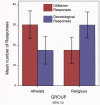Roman Catholic beliefs produce characteristic neural responses to moral dilemmas
- PMID: 23160812
- PMCID: PMC3907925
- DOI: 10.1093/scan/nss121
Roman Catholic beliefs produce characteristic neural responses to moral dilemmas
Abstract
This study provides exploratory evidence about how behavioral and neural responses to standard moral dilemmas are influenced by religious belief. Eleven Catholics and 13 Atheists (all female) judged 48 moral dilemmas. Differential neural activity between the two groups was found in precuneus and in prefrontal, frontal and temporal regions. Furthermore, a double dissociation showed that Catholics recruited different areas for deontological (precuneus; temporoparietal junction) and utilitarian moral judgments [dorsolateral prefrontal cortex (DLPFC); temporal poles], whereas Atheists did not (superior parietal gyrus for both types of judgment). Finally, we tested how both groups responded to personal and impersonal moral dilemmas: Catholics showed enhanced activity in DLPFC and posterior cingulate cortex during utilitarian moral judgments to impersonal moral dilemmas and enhanced responses in anterior cingulate cortex and superior temporal sulcus during deontological moral judgments to personal moral dilemmas. Our results indicate that moral judgment can be influenced by an acquired set of norms and conventions transmitted through religious indoctrination and practice. Catholic individuals may hold enhanced awareness of the incommensurability between two unequivocal doctrines of the Catholic belief set, triggered explicitly in a moral dilemma: help and care in all circumstances-but thou shalt not kill.
Keywords: DLPFC; moral dilemmas; moral emotions; moral judgment; religion.
Figures








Similar articles
-
Testosterone administration in females modulates moral judgment and patterns of brain activation and functional connectivity.Hum Brain Mapp. 2016 Oct;37(10):3417-30. doi: 10.1002/hbm.23249. Epub 2016 May 4. Hum Brain Mapp. 2016. PMID: 27145084 Free PMC article. Clinical Trial.
-
The neural basis of intuitive and counterintuitive moral judgment.Soc Cogn Affect Neurosci. 2012 Apr;7(4):393-402. doi: 10.1093/scan/nsr005. Epub 2011 Mar 18. Soc Cogn Affect Neurosci. 2012. PMID: 21421730 Free PMC article.
-
Gender-related differences in moral judgments.Cogn Process. 2010 Aug;11(3):219-26. doi: 10.1007/s10339-009-0335-2. Epub 2009 Aug 30. Cogn Process. 2010. PMID: 19727878
-
Sidetracked by trolleys: Why sacrificial moral dilemmas tell us little (or nothing) about utilitarian judgment.Soc Neurosci. 2015;10(5):551-60. doi: 10.1080/17470919.2015.1023400. Epub 2015 Mar 20. Soc Neurosci. 2015. PMID: 25791902 Free PMC article. Review.
-
Neural foundation of human moral reasoning: an ALE meta-analysis about the role of personal perspective.Brain Imaging Behav. 2017 Feb;11(1):278-292. doi: 10.1007/s11682-016-9505-x. Brain Imaging Behav. 2017. PMID: 26809288 Review.
Cited by
-
Moral judgment reloaded: a moral dilemma validation study.Front Psychol. 2014 Jul 1;5:607. doi: 10.3389/fpsyg.2014.00607. eCollection 2014. Front Psychol. 2014. PMID: 25071621 Free PMC article.
-
Neural bases of antisocial behavior: a voxel-based meta-analysis.Soc Cogn Affect Neurosci. 2014 Aug;9(8):1223-31. doi: 10.1093/scan/nst104. Epub 2013 Aug 6. Soc Cogn Affect Neurosci. 2014. PMID: 23926170 Free PMC article.
-
Monitoring the neural activity associated with praying in Sahaja Yoga meditation.BMC Neurosci. 2023 Nov 13;24(1):61. doi: 10.1186/s12868-023-00828-x. BMC Neurosci. 2023. PMID: 37957605 Free PMC article.
-
Current Understanding of Religion, Spirituality, and Their Neurobiological Correlates.Harv Rev Psychiatry. 2019 Sep/Oct;27(5):303-316. doi: 10.1097/HRP.0000000000000232. Harv Rev Psychiatry. 2019. PMID: 31490186 Free PMC article.
-
Meanness trumps language: Lack of foreign language effect in early bilinguals' moral choices.PLoS One. 2023 Nov 30;18(11):e0294523. doi: 10.1371/journal.pone.0294523. eCollection 2023. PLoS One. 2023. PMID: 38033023 Free PMC article.
References
-
- Baron-Cohen S, Wheelwright S. The empathy quotient: an investigation of adults with Asperger syndrome or high functioning autism, and normal sex differences. Journal of Autism and Developmental Disorders. 2004;34(2):163–75. - PubMed
-
- Bartels DM. Principled moral sentiment and the flexibility of moral judgment and decision-making. Cognition. 2008;108(2):381–417. - PubMed
-
- Bartels DM, Pizarro DA. The mismeasure of morals: antisocial personality traits predict utilitarian responses to moral dilemmas. Cognition. 2011;121(1):154–61. - PubMed
-
- Berthoz S, Blair RJR, Le Clec'h G, Martinot JL. Emotions: from neuropsychology to functional imaging. International Journal of Psychology. 2002;37(4):193–203.
-
- Berthoz S, Grezes J, Armony JL, Passingham RE, Dolan RJ. Affective response to one's own moral violations. Neuroimage. 2006;31(2):945–50. - PubMed

